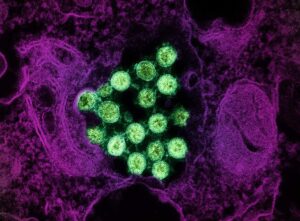A new study adds weight to the evidence that talc raises the risk of ovarian cancer, especially among frequent users and those who use talc-containing intimate care products in their twenties and thirties.
While past research has found an association between talc use and ovarian cancer, those studies are often said to be less reliable due to recall bias — in other words, because they rely on people accurately remembering their past use of talc. Authors of the recent report say their study corrects for such biases.
“Getting an accurate history of lifetime use of genital talc remains a challenge, but we showed that there remains a robust positive association between genital talc use and ovarian cancer even when some misclassification is present,” says lead study author Katie M. O’Brien, PhD, researcher in the Epidemiology Branch of the National Institute of Environmental Health Sciences.
The report, published in the Journal of Clinical Oncology, not only bolsters scientific evidence of a talc-ovarian cancer link but also lends credence to the more than 57,000 legal claims filed against Johnson & Johnson in recent years alleging that the company’s talc-based baby powder caused ovarian cancer. (Johnson & Johnson, which has been manufacturing its iconic baby powder since 1894, last month proposed nearly $6.5 billion to settle the claims, although it maintains its baby powder is “safe, does not contain asbestos, and does not cause cancer.”)
The Issue With Talc
Talc is a naturally-occurring mineral that’s widely used in cosmetics and personal care products, including baby powder and adult facial and body powders, in part because it absorbs moisture and may help prevent skin rashes and chafing.
The issue is that talc, which is mined, can contain asbestos, a known carcinogen. The International Agency for Research on Cancer (IARC) classifies asbestos and talc that contains asbestos as a group 1 known human carcinogen, linking it to cancers of the lung, larynx, and ovary, as well as to mesothelioma, a cancer that forms in the lining of the lungs, chest wall, and abdomen. The IARC also classifies perineal (genital) use of talc-based body powder as “possibly carcinogenic to humans.”
The genital use of body powder burgeoned into a public health debate after asbestos was found in talc products, including baby powder made by Johnson & Johnson, which has over the years issued recalls after lots tested positive for asbestos. Consumer groups and others have sounded alarms about what they say is a lack of adequate regulation and testing of talc products.
The Evidence Grows
This latest study was carried out by researchers at the National Institutes of Health (NIH) and relied on data from 50,884 women ages 35 to 74 enrolled in the Sister Study, one of the largest to collect data on intimate care product use. Positive links between genital talc use and ovarian cancer were consistently found in various analyses done to account for biases or missing data.
In one study sample that corrected for misreporting of talc use, users of genital talc were found to be 40 percent more likely to be diagnosed with ovarian cancer than those who had never used genital talc. The study also found that the level of risk increased along with frequency and duration of use.
The researchers, who in their surveys defined genital talc use as talcum powder applied to a sanitary napkin, underwear, diaphragm, cervical cap, or directly to the vaginal area, also found a particularly increased risk of ovarian cancer associated with genital talc use during a woman’s twenties and thirties. “Results from the present analysis suggest ages 20 to 39 may be a window of susceptibility, which is consistent with prior studies,” they wrote.
“This study shows that use of genital talc is associated with an increased risk of ovarian cancer and builds on prior research on the potential risks of these products, especially for women who used them frequently or during their twenties and thirties,” says American Society of Clinical Oncology expert Fumiko Chino, MD, radiation oncologist at Memorial Sloan Kettering Cancer in Middletown, New Jersey. “The study highlights that not only do these products have no proven health benefits, they’re actually potentially harming people.”
Indeed, several studies have suggested a talc-ovarian cancer link over the years, including a systematic review and meta-analysis published in 2022 that found a 31 to 65 percent increased risk of ovarian cancer associated with frequent perineal or genital powder use among the 66,876 study participants.
While the authors of the NIH study say their analysis can’t prove that talc causes ovarian cancer, they also say there’s no medical reason to use talc. “At the very least, our study’s findings should prompt women to rethink their use of talc products,” Dr. O’Brien says. “We’re not aware of any medically necessary reasons why anyone would need to use talc.”
Current formulations of Johnson & Johnson’s baby powder contain cornstarch, not talc. The company discontinued its talc-based versions from the North American market in 2020, citing declining demand and “misinformation around the safety of the product,” and stopped selling the talc-based powder globally in 2023.











Post Comment